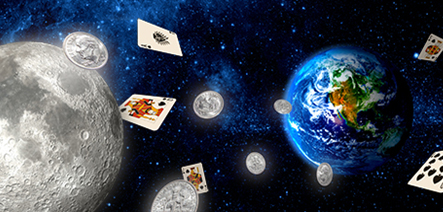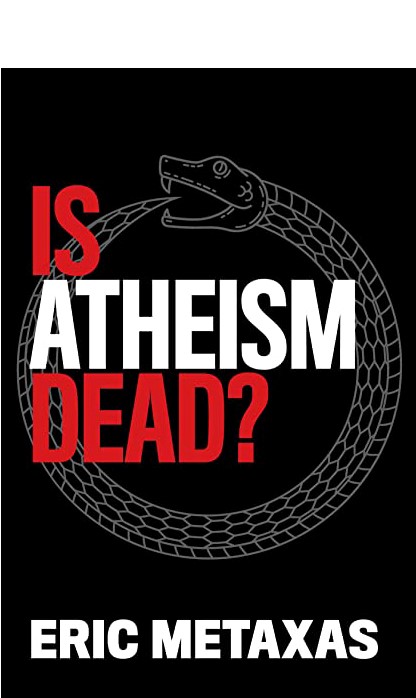Odds

ODDS
Poker, Intelligent Design, and Fine Tuning
Poker Odds
If you’ve ever played poker, or just hung around the competition addicts who do, you probably already know that the Royal Flush is the great-great-granddaddy of all poker hands. That’s because the odds of having it are astronomical. Here’s how you calculate the odds of being dealt a Royal Flush in a five-card game
Card One Odds: 20/52
(any of four Aces, four Kings, four Queens, four Jacks or four Tens in the deck)
Card Two Odds: 4/51
(Assume card one was a Spade so now, you need one of only four specific Spades in the deck)
Card Three Odds: 3/50
(Same as previous card but with smaller deck and fewer drawing options)
Card Four Odds : 2/49
(Same as previous card but with even smaller deck and less drawing options)
Card Five Odds : 1/48
(Same as previous card but with smallest deck and least drawing options)
To calculate cascading odds, simply multiply the fractions. 20/52 x 4/51 x 3/50 x 2/49 x 1/48 = 480/311,875,200 or 1/649,740 or a bit less than the 1/500,000 odds of being struck by lightning sometime in your lifetime. You get the idea that the odds of being dealt a Royal Flush are stacked against you. Still, they are about a thousand times (or ten to the third power) better than your odds of winning the lottery.
The Odds that Count
What are the odds that lifeforms (that would include you and me) could exist within the universe? Back in the mid-twentieth century, the greatest scientific minds agreed that the only two things necessary for life to exist were a star similar in size and energy to our Sun and a planet the right distance from that star, similar to the little blue motorhome in which you and I are currently circling del Sol.
Not surprisingly, as scientific knowledge has evolved over the past seventy years, a lot more “conditions” for life to exist have been discovered. The odds of those conditions are astronomically stacked against the existence of life at all, but here you are, reading this article, and here I sat yesterday, writing it. We defy the odds! But what exactly are those odds?
Fine Tuning
The study of those odds is typically referred to as “Fine Tuning”, sometimes called the “Anthropomorphic Principle”. Let’s look at just one of the scenarios that says we should not exist. If you ever studied physics, or like me, you ever read a book by someone who studied physics, you’ll know there are four fundamental forces in nature – gravity, electromagnetism, the strong nuclear force, and the weak nuclear force. (remember that list so you can sound impressive at your next cocktail party) If these forces were out of synch by even the smallest amount, our universe would not exist. It would have either kept expanding at a rate too fast for life to evolve before being snuffed out or it would have contracted back into the superdaddy of all black holes.
In deference to our abbreviated contemporary attention span, I’ll only illustrate the relationship between two of these forces – gravity and electromagnetism. In order for our universe and all others to exist, the ratio of the electromagnetic force to the gravitational force must be exceedingly delicately balanced to one part in ten to the fortieth power. Expressed as a fraction like the poker odds above, that’s one over ten followed by forty zeros. Such a number is impossible to fathom so here’s an illustration.
Imagine that you covered the entire North American Continent (Alaska, Canada, Continental U.S., Mexico and half of Central America) with a layer of dimes butted up side to side in every direction. Next, imagine you began stacking those dimes until they were higher than the highest mountain in North America. Now, take a smoke break and come back when your arm has recovered from all that stacking. Then, get back to stacking until your continent-covering pile of dimes extends all the way to the moon. Having accomplished this monumental task, you would also have needed one billion friends (yep, that’s even more friends than I have) piling up dimes on their own continents of the same size as North America (visualize a much bigger planet). Now that your impressive networking group has completed the grand experiment, imagine that one of your mischievous network partners admits to having painted a single dime red. That one red dime in the super-collection of dimes represents the amount of variance within the ratio of electromagnetism to gravity that would throw the laws of physics out of whack so that not only our universe, but our planet, our continent, our state, your office, and the very computer screen (or phone) you’re reading this on would simply go poof! Your chair would be gone too but don’t worry, you wouldn’t fall to the floor and injure your back because your back would be non-existent as well.
That’s just one single known condition for life to exist. Add to it the requirements of the Earth’s specific size to maintain an appropriate atmosphere, its distance from and correct orbit around the sun, the need for planetary giants like Jupiter and Saturn to protect us from asteroids, the appropriately sized moon to create tidal basins, location and type of our spiral galaxy, and on and on and on. Now, remember, each of those odds get multiplied by all the others just like the poker illustration. We’re gonna need a whole lot more friends and a bunch more dimes and even more real estate than Ebby can come up with.
All of this led Fred Hoyle, the acclaimed Astrophysicist and atheist who sarcastically coined the phrase “Big Bang” to admit, “A common sense interpretation of the facts suggests that a super intellect monkeyed with physics, as well as chemistry and biology, and that there are no blind forces worth speaking about in nature.” Fred may be an atheist but above all, he’s committed to going with the facts, not his emotions.
Don’t take my word for this. Get the two books I mention below and just skim their bibliographies. Be forewarned however, that one of those bibliographies is roughly fifty pages long with 25 books per page. These guys are research junkies.
Then, hit that reply button and let’s discuss what you discovered.
“The art and science of asking questions is the source of all knowledge”
— Thomas Berger
Great Reads. Even Better Listens
Is Atheism Dead
Eric Metaxas
More than a book about faith, “Is Atheism Dead” chronicles the incredible advances in science over the past fifty years. Metaxas can be a little cocky about his faith and knowledge but he brings a host of salient facts to the table with regard to the Fine Tuning argument. More important, he backs up his claims with serious research and documentation. His bibliography is possibly the ultimate reading list.

Evidence That Demands a Verdict
Josh McDowell
Now in it’s fourth edition, this book and author represent what intellectual honesty is all about. When I read the first edition back in 1974, I was impressed by McDowell’s telling of his original quest as a young atheist attorney to amass what would be legally admissible documentation in an American courtroom that the concept of God is a hoax. After two years of diligent research, he revised his conclusion but he’s still researching.












